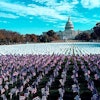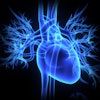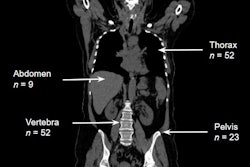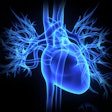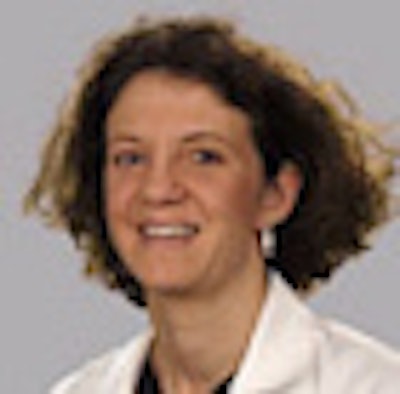
Dr. Gia Deangelis, a radiologist from the University of Virginia in Charlottesville, was supposed to be in Port-au-Prince the day the quake struck. She is now working in a rural clinic in Grison-Garde, north of the decimated capital of Port-au-Prince. Here are her observations about the situation in Grison-Garde and Cap-Haitien, located on the north coast of Haiti, one of the cities people from Port-au-Prince are now coming to in search of food and medical help.
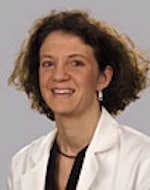 |
| Dr. Gia Deangelis, University of Virginia. |
In August, I served as a consultant for Doctors Without Borders (Médecins Sans Frontières), teaching ultrasound at Maternité Solidarité, a 75-bed hospital they built to provide dedicated emergency obstetrical care in Port-au-Prince. Similar to all hospitals in Port-au-Prince, it has been badly damaged, and pregnant mothers and newborns have been evacuated.
Port-au-Prince was a very livable city with a vibrant, international community, and it's now devastated. The economic and intellectual fabric, in particular, has suffered. The universities, government buildings, restaurants, and much of the cultural life were centered in Petionville, a suburb of Port-au-Prince, but are now destroyed. Many students from elsewhere in Haiti, who were sent to these secondary schools and universities in Port-au-Prince, have died.
Because Haiti was centralized with Port-au-Prince as its hub, the rest of Haiti was dependent on the operation of the capital city. The banks are indefinitely closed and cash cannot be obtained easily. Cellular phone and Internet service have been affected; hence, communication is difficult everywhere in the country. In Port-au-Prince, many of the wounded were not able to reach available medical aid because of poor communications.
The impact of the earthquake on Cap-Haitien is significantly greater than I initially imagined. The second largest city in Haiti and 200 miles by road to the north, Cap-Haitien, was not hit as hard by the earthquake as Port-au-Prince, but it had immediate loss of communication and electricity. A critical fuel shortage followed shortly afterward.
To get here, our own plane had to refuel in the Bahamas because Cap-Haitien was out of fuel. Electricity and communication have now been restored in Cap-Haitien, although resources are becoming critical as people flood into this relatively poor city from Port-au-Prince.
We're in the middle of this mess in many respects. On top of all that has already happened, another earthquake just occurred today (January 20) (magnitude 6), and we felt those tremors here.
Justinian Hospital, the public hospital in Cap-Haitien, has seen a large influx of injured from Port-au-Prince because there were no functioning hospitals there immediately after the earthquake. Many of the patients coming from Port-au-Prince didn't come with resources. There were several groups here in Cap-Haitien who pooled resources to pay for a food program for staff and patients, at least during this most acute period.
Some significantly injured people have come to Justinian Hospital -- either by personal means or via the buses the mayor of Cap-Haitien has set up to bring supplies to Port-au-Prince and to return with injured. Port-au-Prince is overwhelmed with untreated injuries. Most injuries are orthopedic-related, with many compound fractures and traumatic amputations. The crucial steps of washing the wounds and at least aligning the fractures have been done and IV antibiotics given. Many are now waiting for more definitive orthopedic repair.
 |
| This boy was one of only six survivors out of approximately 600 students in a school that collapsed in Petionville, Port-au-Prince. His parents perished in the quake. He heard about our clinic and, like others, came here. All photos courtesy of Dr. Gia Deangelis. |
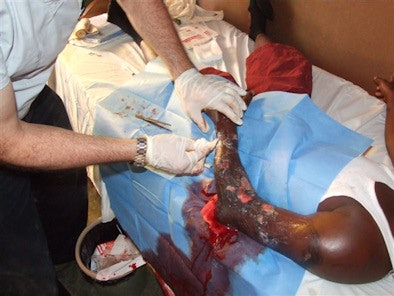 |
The boy shown in the images above had his arm trapped under concrete for almost two days. The demarcation on his shoulder indicates where the edge of the concrete was and the skin excoriation resultant from the crush, pressure, and edema. The boy needed wound care for his crush injury, and we saw him every day this week and have follow-up care by one of our colleagues, Eugene Maklin, a Haitian physician here.
We gave him rocephin IM plus oral antibiotics. The swelling improved somewhat, although the elbow seemed more indurated and swollen. We aspirated purulent blood with an 18-gauge needle and then opened and drained the joint in the clinic. There were not a lot of other options for hospitals, but the case is likely adequate for management.
He has a likely Colles' fracture. It's pretty well aligned, so no manipulation may be required. One certainly would not want to do surgery at this point, even if it was needed for alignment; the crush injury is bad enough not to add further trauma from surgery.
We had another kid yesterday who came up from Port-au-Prince with a visually deformed Colles', which we realigned. Radiographs would probably not add much to management -- we can also predict what the radiographs would look like judging from the deformity.
Justinian Hospital, the public hospital in Cap-Haitien, is overwhelmed with patients waiting to be seen. The beds are mainly occupied by those with more serious injuries including open fractures.
The group I usually go with to Port-au-Prince (the Haiti Mission) and several other groups currently here have established strong ties with the Haitian community in Cap-Haitien. One, the Rotary Club of Cap-Haitien, has effectively coordinated relief efforts from Cap-Haitien to both Port-au-Prince and the Justinian Hospital here.
The Cap-Haitien airport is Haiti's second main airport, and entrance to and from Haiti for relief efforts is not as limited as it is in Port-au-Prince. Buses and car transport between these two cities is accessible and takes only a few hours. Aid is coming in through Cap-Haitien by air and the port.
Peggy Ramsey, the owner of Bimini Island Air (the airline we use), has made her flights available for flying in medical equipment. The greatest need at many of the hospitals is actually getting equipment, and less so with personnel. Between our three groups currently together in Cap-Haitien, we have pooled our resources and are spending an additional $20,000 on food and supplies for Justinian Hospital. Some of the big items that we need include orthopedic equipment; the need is very great. Drugs like Lovenox (which prevents clotting) are also high on the list.
At our own clinic in Grison-Garde, we are seeing a significant number affected by the earthquake. They made the hour-long trip by tap-tap (cabs that serve as mass transportation in Haiti) to this rural clinic only because they heard there was medical staff at this clinic this week. Several had untreated fractures; the particular distortion indicated the likely type of fracture.
One member of our group, Andy Guertler, aligned and casted a likely Colles' fracture in a 12-year-old child. The lidocaine injected at the fracture site was not effective because the fracture was already a week old, but the boy visibly bore the manual resetting of the bones. This type of acceptance and calmness is so typical of the Haitian people, perhaps in some part because of the difficulty they have learned to accept.
We saw a woman in our clinic in Grison-Garde who has six kids in Port-au-Prince and three children here. Her sisters died in Port-au-Prince. Her husband is in Santa Domingo and hasn't been heard from for four years, a typical occurrence. Her children have a high likelihood of becoming malnourished.
By Dr. Gia Deangelis
AuntMinnie.com contributing writer
January 22, 2010
Related Reading
Philips, Caritas Christi join forces in Haiti relief, January 21, 2010
ASRT donates $10,000 for Haiti disaster relief, January 20, 2010
Radiology mobilizes to help Haiti in wake of devastating earthquake, January 19, 2010
For doctors in Haiti, worst is yet to come, January 19, 2010
Copyright © 2010 AuntMinnie.com
